

Leman Street Directory 1921
|
West Side
2 Mrs Sadie Max, milliner 4 Joseph Moshinsky & Son, tobacconists 8 Jacob Semel, blouse maker 10 Jacob Lazarus, fried fish shop 14 Cushi Albert Punter, farrier [1] ... here is Beagle Street ... J Landau & Sons, government contractors (Beagle Street) [2] 16 Baker & Basket, Henry Levy Steingold [3] 18 & 20 Charles Wills, saddler 22 Browne & Eagle Limited, wool warehouse keepers ... here is Duncan Street ... 26 Marks Rubin, cooked beef dealer 28 Henry Rodney Foakes, dairy 30 Abraham Korinsky, confectioner 34 Manor Laundry (Camberwell) Ltd [4] 36 H Ginzburg, printer 38 Kritz Barnett & Son, wardrobe dealers [5] ... here is Great Alie Street ... 40 Black Horse, Mrs Sarah King [6] 42 & 44 P Mellis & Sons Ltd, india rubber waste merchants [7] 46 Harris Hart, tailor 48 Solomon Berman, confectioner 50 Lewis Leibson, woollen merchant 58 Morris Berkin & Son, hat manufacturers 60 Aaron Moses, wholesale haberdasher [8] 62 Philip Leslie, loan office [66 - details here] 70 Garrick, Edward Eugene Wherley [9] 74-78 Police Station [10] 82 Jews' Temporary Shelter 100 English & Scottish Co-operative Wholesale Societies [11] ... here is Great Prescott Street ... 110-118 (& 99) Co-operative Wholesale Society Ltd 110 Minesweepers Co-operative Trawling Society Ltd [12] 116 & 118 (& 99) Co-operative Wholesale Society Ltd ... here is Chamber Street ... 130 James Seaford, wholesale clothier John Pound & Co, dressing case manufacturers (2 to 12 Imperial Buildings) [13] ... here are Royal Mint Street & Cable Street ... |
East Side
1 Julius Farbstein, hairdresser 3-7 Barthes-Roberts Ltd, cork merchants [14] 9 Barnett Kachar, kosher restaurant ... here is Colchester Street ... 11 Matthew Beer & Co, rope manufacturers 13 Walter Francis Reckitt, surgeon [15] 15 Israel Jacobovitch, hairdresser 15 Lazarus Pearlman, confectioner 17 Jewish Working Girls Club, Miss Isabel Harris, superintendent [16] 19 Seamen's National Insurance Society [17] ... here is Buckle Street ... Eastern Dispensary, George W Ilsley, secretary ... here is Little Alie Street ... 21A (& 61) John Robert Siddall, carpenter 21A Mrs Sarah Lindsberg, tobacconist 23 Tooths Extract of Meat Company [18] 23 Mace, Rainbow & Stone, costume manufacturers [19] 23 Minerva Manufacturing Company [20] 25 Jacob Galinsky, butcher 27 Nathan Jacobs, grocer 29 Jack Alteresko, dining rooms [21] 31 Solomon Petergorsky, gasfitter 33 Morris Fordonski, waterproofer 37 (& 41 & 57) Anchor Co-operative Society Ltd [22] 39 Jacob Josopovitch, fruiterer 41 (& 37 & 57) Anchor Co-operative Society Ltd [22] 43 White Hart, Ralph Cartoof [23] 45-51 Crane-Bennett Ltd, engineers [24] 53 & 55 Penny & Hull, printers [25] 53 & 55 Roman & Needlestitcher, tailors 53 & 55 Weinstein & Cohen, tailors 57 (& 37 & 41) Anchor Co-operative Society Ltd [22] 59 Andrew Golebiewski, boot maker 61 Mrs Esther Solomons, wardrobe dealer 61 (& 21A) John Robert Siddall, carpenter 63 Davis Beigel, hairdresser ... here is Leman Passage ... 65-73 Charles Hughes Cousens & Co, wool warehouse keepers 99 & 110-118 Co-operative Wholesale Society Ltd ... here is Hooper Street ... 119 East End Mission to the Jews, David Openshaw (?), secretary [26] 121 Morris Baranovsky, boot maker 123 Jacob Shimansky, watch maker 125 Marks Goldberg, clothier 127 Leman Street Drug Stores Ltd 129 Mrs Elizabeth Blake, coffee rooms 131 Morris Segal, hairdresser 133 Charles Ernest Upshall, newsagent 135 Simon White, fruiterer 137 Midland Railway (London, Tilbury & Southend Section), managers office, goods depot 139 Brown Bear, Joseph Davis [27] 141 Hyman Hoffman, tobacconist 143A William Wesson Ltd, coopers Great Eastern Railway Station [Leman Street] 155 George Carter Ltd, grocers & tea dealers |
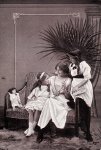 [3] The Baker & Basket's
original address was 12 Red Lion Street, and from 1851-71 8 Leman
Street; it was sold in 1852 with a number of other pubs. The publicans
Ernest Edward and Mary McHard died on 19 April 1941 in the Blitz.
[3] The Baker & Basket's
original address was 12 Red Lion Street, and from 1851-71 8 Leman
Street; it was sold in 1852 with a number of other pubs. The publicans
Ernest Edward and Mary McHard died on 19 April 1941 in the Blitz. 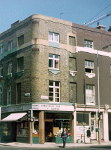
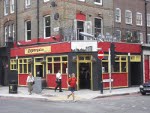
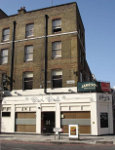 [5]
This corner site is shown left in 1977 - this block (32-38) is now Frazer House,
including White's Gentleman's Club offering 'adult entertainment'.
[5]
This corner site is shown left in 1977 - this block (32-38) is now Frazer House,
including White's Gentleman's Club offering 'adult entertainment'. [7] Although listed as india rubber waste merchants, P. Mellis & Sons had diversified. Their 1921 advertisement [right] in Das Echo: Mit Beiblatt Deutsche Export Revue. Wochenzeitung Für
Politik, Literatur, Export und Import (vol 40) states: Old
established firm with warehouse and own salesmen and agents in Great
Britain and colonies. Will act as main supplier for chemicals, drugs,
technical articles, hardware, &c. We only deal with manufacturers. Best bank and commercial references. The listings recorded Well
established agency, which also operates all over Spain on commission.
Reliable agency for German firms. Correspondence in German, French and
Spanish. Impeccable references can be provided.
[7] Although listed as india rubber waste merchants, P. Mellis & Sons had diversified. Their 1921 advertisement [right] in Das Echo: Mit Beiblatt Deutsche Export Revue. Wochenzeitung Für
Politik, Literatur, Export und Import (vol 40) states: Old
established firm with warehouse and own salesmen and agents in Great
Britain and colonies. Will act as main supplier for chemicals, drugs,
technical articles, hardware, &c. We only deal with manufacturers. Best bank and commercial references. The listings recorded Well
established agency, which also operates all over Spain on commission.
Reliable agency for German firms. Correspondence in German, French and
Spanish. Impeccable references can be provided. 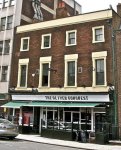
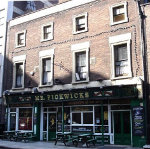
 [9] The Garrick was attached to the adjoining Garrick Theatre
(also known as Garrick's Subscription), opened in 1831; it was named
for the actor David Garrick, who had made his début at the Goodman's
Fields Theatre in 1741, as Richard III. Early proprietors were Edward Gomasal and
William James Bennett and its manager was Benjamin Oliver Conquest (1805-72), a 'low comedian' most famous for his rendition of Billie Barlow [right]. When
the theatre burned down in 1846 he took over the Grecian Theatre, where
he organised pantomimes featuring his son George, the most spectacular
acrobatic performer of his day. The Garrick theatre was rebuilt
between 1852-54, as the The Albert and Garrick Royal Amphitheatre.
Lawrence Levy, the proprietor, managed it off and on until 1868, when
he put it up for sale - grossly exaggerating its capacity. Empty for
several years in the 1870s, after the bankruptcy of its actor manager
J.B. Howe, it limped on as the Garrick Hall of Varieties under May
Bulmer, until closure and demolition in 1891.
[9] The Garrick was attached to the adjoining Garrick Theatre
(also known as Garrick's Subscription), opened in 1831; it was named
for the actor David Garrick, who had made his début at the Goodman's
Fields Theatre in 1741, as Richard III. Early proprietors were Edward Gomasal and
William James Bennett and its manager was Benjamin Oliver Conquest (1805-72), a 'low comedian' most famous for his rendition of Billie Barlow [right]. When
the theatre burned down in 1846 he took over the Grecian Theatre, where
he organised pantomimes featuring his son George, the most spectacular
acrobatic performer of his day. The Garrick theatre was rebuilt
between 1852-54, as the The Albert and Garrick Royal Amphitheatre.
Lawrence Levy, the proprietor, managed it off and on until 1868, when
he put it up for sale - grossly exaggerating its capacity. Empty for
several years in the 1870s, after the bankruptcy of its actor manager
J.B. Howe, it limped on as the Garrick Hall of Varieties under May
Bulmer, until closure and demolition in 1891. 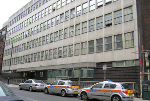
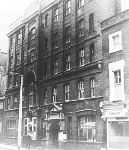 [10] Leman Street Police Station was
built on the site of the theatre in 1891 [right - then and now]. It was associated with the Ripper murders and the
Cable Street riots, but is no longer a local station - it is used for
special operations. Many of the police used to drink at the Brown Bear.
[10] Leman Street Police Station was
built on the site of the theatre in 1891 [right - then and now]. It was associated with the Ripper murders and the
Cable Street riots, but is no longer a local station - it is used for
special operations. Many of the police used to drink at the Brown Bear. 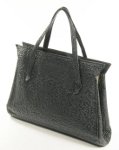
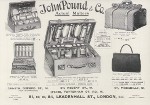
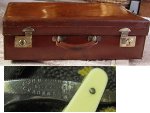 [13]
Pound and Tasker was established in 1823, making trunks and packing
cases. When Tasker died in 1857 Henry Pound took on his son John, who
after Henry's death established John
Pound & Co.
as a manufacturer and retailer of high quality
luggage and luxury dressing cases. By 1871 they had three factories,
eight distributing warehouses and five shops in central London - Regent
Street, Oxford Street, Piccadilly, and Tottenham Court Road as well as
Leadenhall Street. They also made and sold hunting bags, hat cases,
writing cases, purses and other high-class items. John Pound was Lord
Mayor of London in 1904, and control passed to his sons John Lulham and
Percy Albert. They continued to trade until after the Second World War,
when they were taken over by John Lewis.
[13]
Pound and Tasker was established in 1823, making trunks and packing
cases. When Tasker died in 1857 Henry Pound took on his son John, who
after Henry's death established John
Pound & Co.
as a manufacturer and retailer of high quality
luggage and luxury dressing cases. By 1871 they had three factories,
eight distributing warehouses and five shops in central London - Regent
Street, Oxford Street, Piccadilly, and Tottenham Court Road as well as
Leadenhall Street. They also made and sold hunting bags, hat cases,
writing cases, purses and other high-class items. John Pound was Lord
Mayor of London in 1904, and control passed to his sons John Lulham and
Percy Albert. They continued to trade until after the Second World War,
when they were taken over by John Lewis.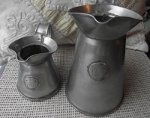
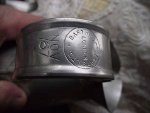
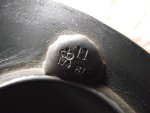 [14] Barthes-Roberts, founded in 1779, were cork merchants and manufacturers, brewers'
and bottlers' agents and sundriesmen, and manufactured both utilitarian
items (such as the metal one-third and 1-pint jugs used at
London docks for collecting samples of imported wine, left)
and more classy items, such as silver-plated spirit dispensers. Their
stamp, and a royal seal, are also pictured. In 1930, when they
amalgamated with Beal, French & Son, Thomas Peet & Son and Todd
& Peet, The Record
produced 'A Short History of 150 Years Trading - Barthes-Roberts Ltd.'
Latterly their trading address was 59 Lant Street SE1; the company was
wound up in 1983.
[14] Barthes-Roberts, founded in 1779, were cork merchants and manufacturers, brewers'
and bottlers' agents and sundriesmen, and manufactured both utilitarian
items (such as the metal one-third and 1-pint jugs used at
London docks for collecting samples of imported wine, left)
and more classy items, such as silver-plated spirit dispensers. Their
stamp, and a royal seal, are also pictured. In 1930, when they
amalgamated with Beal, French & Son, Thomas Peet & Son and Todd
& Peet, The Record
produced 'A Short History of 150 Years Trading - Barthes-Roberts Ltd.'
Latterly their trading address was 59 Lant Street SE1; the company was
wound up in 1983. |
contains those valuable nutritious
constituents of fresh meat which are peculiar to animal food. In the
words of Professor Liebig, it is "solid Beef Tea"—that is, beef tea
from which the water has been evaporated. It dissolves immediately in
hot water, and is thus a most convenient as well as efficient and
economical substitute for meat in making beef tea, soups, and gravies;
in fact, with the addition of bread or other farinaceous food, it has
the full nutritive effect of meat. "It contains the essential and important constituents of meat which are lost by salting. Hence, if added to salted and smoked meats, it imparts to them all the nutritive qualities of fresh meat."—See Times, Oct. 27th, 1865. It is therefore peculiarly valuable at sea. It does not spoil by keeping even in a loosely covered jar. One ounce of the Extract contains the soluble matter of about two pounds of fresh meat, free from fat. |
| ... It would be unfair not to say a few words respecting the service done
to the people of Paris by the Extractum Carnis. I and some of my
friends have made large use of Tooths' preparation and the various
others and we have found them excellent. There is little, if any, of
the English extracts left in stock now. A French company, having
adopted the absurd title, "Of Meat", which pronounced in French "Of
mėá" becomes exceedingly ludicrous to English ears, has pushed
its extract with great assiduity for some time, and tells the world
that the extract made by the Of Meat Company is infinitely superior to
that prepared on Liebig's plan. It had a considerable stock at the
commencement of the siege, but its retail establishment is almost empty
now. An Italian company has lately made its appearance with an extract
which is also Liebig perfectionné, and as it makes a good show it
will not want for customers. The feeding of the poor is indeed a serious matter under the circumstances in which we are placed and the Government has set aside an additional sum equal to 20,000l. for the establishment of new economic kitchens for the supply of the indigent. It has allowed 7½d. a day to the wives of all the men in the National Guard who may apply for it, in addition to the pay of 15d]. to the men themselves. Now that the thermometer is several degrees below freezing, and the ground is covered with snow, all the aid that public and private charity can supply is, as may be supposed, fully required ... |
 [19] Mace, Rainbow & Stone made ladies' outwear,
or costumes, here; their registered office was at 25 Berners Street W1
(later 8 Upper Grosvenor Street W1). In 1928 they featured in a High
Court action under the 1893 Sale of Goods Act, as part of a chain of
suppliers: they had bought collars made of dyed rabbit skin from
a furrier, attached them to coats and sold them to a supplier, who in
turn sold them to a draper. Miss White bought one of these coats and
developed 'fur dermatitis' from the antimony in the fur, and sued for
damages; how far down the chain should these be passed? In 1949 they
were one of three clothing firms to relocate to Cornwall - to
'Ormadale', New Portreath Road, Redruth, extending their premises in
1958 [right]. In 1963
they patented the 'Naehmaschine', an automatic sewing apparatus. They
employed 95 staff, and in 1975 R.G. Brett became an Associate of the
Institute of Directors. Yet the following year the company - along with
others in Cornwall - went into voluntary liquidation.
[19] Mace, Rainbow & Stone made ladies' outwear,
or costumes, here; their registered office was at 25 Berners Street W1
(later 8 Upper Grosvenor Street W1). In 1928 they featured in a High
Court action under the 1893 Sale of Goods Act, as part of a chain of
suppliers: they had bought collars made of dyed rabbit skin from
a furrier, attached them to coats and sold them to a supplier, who in
turn sold them to a draper. Miss White bought one of these coats and
developed 'fur dermatitis' from the antimony in the fur, and sued for
damages; how far down the chain should these be passed? In 1949 they
were one of three clothing firms to relocate to Cornwall - to
'Ormadale', New Portreath Road, Redruth, extending their premises in
1958 [right]. In 1963
they patented the 'Naehmaschine', an automatic sewing apparatus. They
employed 95 staff, and in 1975 R.G. Brett became an Associate of the
Institute of Directors. Yet the following year the company - along with
others in Cornwall - went into voluntary liquidation.  [24] Crane Limited was a Canadian firm of heating and sanitary engineers, and Crane-Bennett Ltd. its British subsidiary. Their foundry was in Ipswich, and they had
showrooms in various locations, but the grandest was at 120 Pall Mall [left],
designed by Sir Edwin Lutyens and built in 1929–31 (with delays to
secure the foundations of the neighbouring buildings). The basement,
ground and first floors were designed as showrooms, with a visitors'
lounge in the mezzanine at the back. The other floors were to let
separately as offices. Lutyens also designed two model bath-rooms for
the displays and furniture for the visitors' lounge. But in 1932 the
firm vacated the premises, which were later taken over by the Holland
America Line (London) Limited - it is now Banco Sabadell.
[24] Crane Limited was a Canadian firm of heating and sanitary engineers, and Crane-Bennett Ltd. its British subsidiary. Their foundry was in Ipswich, and they had
showrooms in various locations, but the grandest was at 120 Pall Mall [left],
designed by Sir Edwin Lutyens and built in 1929–31 (with delays to
secure the foundations of the neighbouring buildings). The basement,
ground and first floors were designed as showrooms, with a visitors'
lounge in the mezzanine at the back. The other floors were to let
separately as offices. Lutyens also designed two model bath-rooms for
the displays and furniture for the visitors' lounge. But in 1932 the
firm vacated the premises, which were later taken over by the Holland
America Line (London) Limited - it is now Banco Sabadell.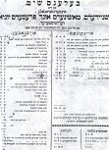
 publications in English and Hebrew for the Jewish community, including [right] Laws of the Board for administering the affairs of Shehitah 1880), International Tailors' Machinists' & Pressers' Union (1890, in Hebrew); also sermons preached by Basil Henriques, including
'The House of the Lord: A Sermon Preached at the Jews' Hospital and
Orphan Asylum at the Re-opening of the Synagogue After the Completion
of the Alterations Carried Out in Memory of David Q. Henriques at a
Special Service on October 31st 1915', and 'Denzil Alex Myer Memorial
Sermon: Delivered at the East London Synagogue ... May 13, 5677' (1917)
publications in English and Hebrew for the Jewish community, including [right] Laws of the Board for administering the affairs of Shehitah 1880), International Tailors' Machinists' & Pressers' Union (1890, in Hebrew); also sermons preached by Basil Henriques, including
'The House of the Lord: A Sermon Preached at the Jews' Hospital and
Orphan Asylum at the Re-opening of the Synagogue After the Completion
of the Alterations Carried Out in Memory of David Q. Henriques at a
Special Service on October 31st 1915', and 'Denzil Alex Myer Memorial
Sermon: Delivered at the East London Synagogue ... May 13, 5677' (1917)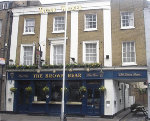 [27] The Brown Bear was in existence by the 1790s and was rebuilt in 1830; its address was then no.89, and no.77 in the 1850s. From 1848-66, when William Brand was
the licensee, it held a music hall licence, and was described as
the scene of orgies and murderous assaults; but by 1908 London in the
Sixties (with a Few Digressions), by 'One of the Old Brigade', says its
rooms were filled to their utmost capacity with canaries sending up
songs to heaven purer far than those of the long-ago sixties. From
1917-26 its landlord was Joseph Davis, an orthodox Jew born in Minsk in
1868, previously a boot and shoe maker, one of the founders of the
Cannon Street Road synagogue and of Talmud Torah in Christian Street.
The family previously lived in Langdale Street, off Cannon Street Road,
where Jewish and Irish settlers had co-existed happily (this was to
change by the 1930s). His son Morry (Morris Aaron, or Harold), also for
a time a publican, was both President of the Federation of Synagogues
from 1928-44 and Mayor of Stepney, Labour Leader of the Council and
member of the London County Council.
[27] The Brown Bear was in existence by the 1790s and was rebuilt in 1830; its address was then no.89, and no.77 in the 1850s. From 1848-66, when William Brand was
the licensee, it held a music hall licence, and was described as
the scene of orgies and murderous assaults; but by 1908 London in the
Sixties (with a Few Digressions), by 'One of the Old Brigade', says its
rooms were filled to their utmost capacity with canaries sending up
songs to heaven purer far than those of the long-ago sixties. From
1917-26 its landlord was Joseph Davis, an orthodox Jew born in Minsk in
1868, previously a boot and shoe maker, one of the founders of the
Cannon Street Road synagogue and of Talmud Torah in Christian Street.
The family previously lived in Langdale Street, off Cannon Street Road,
where Jewish and Irish settlers had co-existed happily (this was to
change by the 1930s). His son Morry (Morris Aaron, or Harold), also for
a time a publican, was both President of the Federation of Synagogues
from 1928-44 and Mayor of Stepney, Labour Leader of the Council and
member of the London County Council.Back to Goodmans Fields